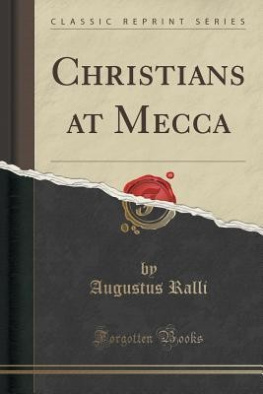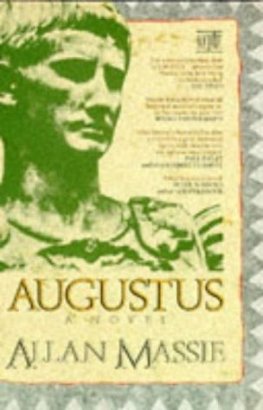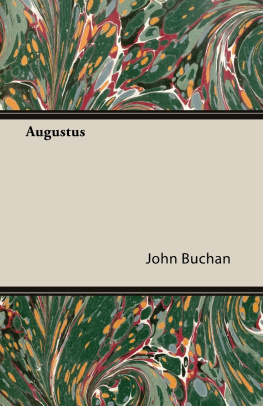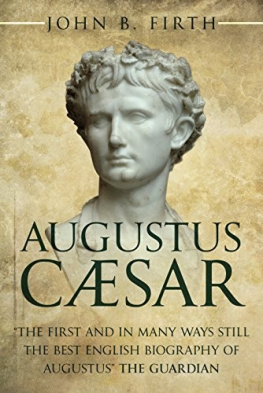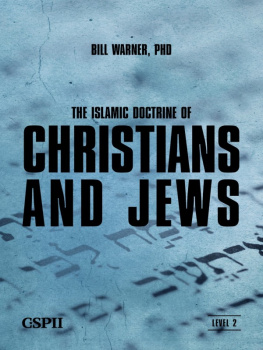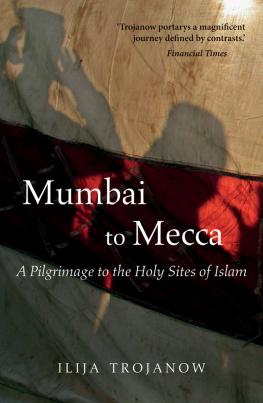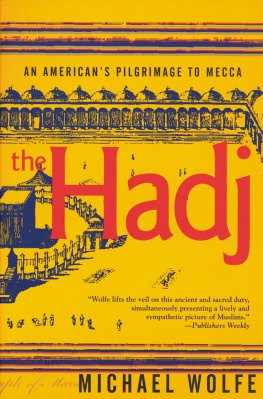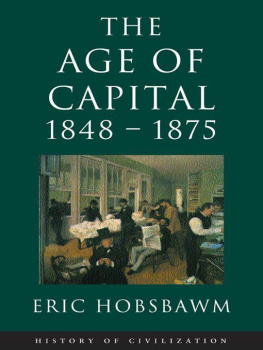CHRISTIANS AT MECCA
SSv
>M
ffl&
IOjWt?' i*
CM
CO
>-
UGUSTUS RALLI
CHRISTIANS AT MECCA
UNIFORM WITH THIS VOLUME
DAYS IN HELLAS. By Mabel
Moore. With numerous Illustrations and Coloured Frontispiece. In One Vol. Crown 8vo, price 6s. net.
CARTHAGE OF THE PHOENI- CIANS IN THE LIGHT OF MODERN EXCAVATION. By Mabel Moore. In One Vol. Crown 8vo, Illustrated, price 6s.
LONDON: WILLIAM HEINEMANN 21 Bedford Street, W.C.
I
< I ,'
Principal Gate of the Mosque at Medina.
From a photograph by Gervais-Courtellemont in " LI 'Illustration, ( )ctober 3, 1908.
CHRISTIANS AT MECCA
BY
AUGUSTUS RALLI
ILLUSTRATED
" At this day, those who know that any European has tried to reach Mecca, for the most part believe that Burton alone succeeded." D. G. Hogarth.
LONDON
WILLIAM HEINEMANN
1909
V*
,'.'..' ; * ::..:.;.-
Copyright, London, 1909, by William Heinemann
PREFACE
My object in the following pages has been to give a narrative of each pilgrim's adventures, and a summary of his observations of the people of Mecca and the condition of the city. These are the things that change from age to age. What do not change are the rites of the Pil- grimage and the appearance of the Great Mosque. Having, therefore, described these in the opening chapters, I have omitted, in the case of each individual traveller, all but personal and charac- teristic touches.
As I write for the general reader I have not adopted the ultra correct method of spelling Arabic names. For words such as Badazvi, Aarab, Ullah will be found the more familiar Bedouin, Arabs, Allah.
72788
CONTENTS
NO. PAGE
I. Mecca i
II. The Great Mosque 5
III. The Pilgrimage. (Haj) 9
IV. Medina 19
V. Ludovico Bartema, 1503....23
VI. Vincent Le Blanc, 1568....29
VII. Johann Wild, 1607 34
VIII. Joseph Pitts, 1680 40
IX. Badia y Leblich, 1807. (Ali Bey El Abbassi) 48
X. Ullrich Jasper Seetzen, 1809-10. (Haj
Moosa) 65
XI. John Ludwig Burckhardt, 1814-15.
(Shaykh Haj Ibrahim) .... 74
XII. Giovanni Finati, 18 14. (Haj Mohammed) 102
XIII. Leon Roches, 1841-2. (Haj Omar) .. 121
XIV. George Augustus Wallin, 1845. (Wali
al-din)........ 156
XV. Sir Richard Burton, 1853. (Shaykh haj
Abdallah) 161
XVI. Heinrich Freiherr von Maltzan, i860. (Sidi Abd-er Rochman Ben Mohammed es Skikdi) 191
viii CONTENTS
NO. PAGE
XVII. Herman Bicknell, 1862. (Haj Abd-El-
Wahid) 200
XVIII. John Fryer Keane, 1877-8. (Haj Mo- hammed Amin) 204
XIX. Christian Snouck Hurgronje, 1885.
(Abd'-el-Gaffar) 223
XX. Gervais-Courtellemont, 1894. (Abdallah) 244
XXI. Miscellaneous 261
XXII. The Hejaz Railway Conclusion... 272
Bibliography 277
INDEX 279
LIST OF ILLUSTRATIONS
Principal Gate of the Mosque at Medina . Frontispiece
From a photograph by Gervais-Courtellemont in " L 'Illustration" October?,, 190S
FACING PAGE
View of Mecca 2
From a photograph by C. Snouck Hnrgronje in ' ' Bilder aus Mekka "
The Mosque and Kaabah 8
From a photograph by C. Snouck Hurgro?ije in ' ' Bilder aus Mekka "
View of Mecca 12
From a photograph by C. Snouck Hnrgronje in "Bilder aus Mekka "
Court of Mosque at Medina 20
From a photograph by Gervaise-Courtellemont in " L' Illustra- tion," October 3, 1903
Court of Mosque showing the Kaabah .. 54
From a photograph by C. Snouck Hurgronje in ' ' Bilder aus Mekka "
John Lewis Burckhardt 74
Southern Wall of Mosque at Medina ... 94
From a photograph by Gervais-Courtellemont in " L' Illustra- tion" October 3,11908
x LIST OF ILLUSTRATIONS
FACING PAGE
The Niche before which Mohammed Prayed . 98
From a photograph by Gervais-Courtellemont in " L' 'Illustra- tion" October 3, 1908
The Main Street of Medina leading to the
Mosque '74
From a photograph by Gervais-Courtellemont in " L' Illustra- tion," October 3, 190S
C. Snouck Hurgronje 224
CHRISTIANS AT MECCA
i
MECCA
It would be of interest to know how far Macaulay's schoolboy was acquainted with Mecca. That it is the centre of the Mohammedan faith and the object of a Pilgrimage, seems to exhaust popular knowledge. I once expressed to a friend my opinion that a visit to Mecca would be of in- comparable interest ; in reply he advised me not to make that visit during the Pilgrimage. When I rejoined that no Christian might look on the holy city of Islam and live, he asked in astonish- ment if the prohibition extended even to Cook's tourists !
Mohammed was born at Mecca about a.d. 570. In his fortieth year he became conscious of his divine mission. The reforms which he proposed to initiate were ill pleasing to the ruling tribe, known as the Koreysh. Persecuted, and his life in danger, he fled to Medina. From the year of his flight, A.D. 622, dates the Hegira or Moslem era. Well received by the people of Medina, and surrounded by his friends, he proceeded to
A
2 CHRISTIANS AT MECCA
propagate his doctrines by the sword. In a.d. 629 he returned triumphant to his native city ; and that year saw the decree that no Unbeliever should thenceforth set foot in Mecca.
If we except the story of the Englishman dis- covered by the authorities and expelled as an idiot, no infraction of this decree, once brought to light, has had other than tragic consequences. Doughty, on the testimony of two troopers who rode with the Damascus caravan, informs us that scarcely a Pilgrimage takes place without some persons being put to death as intruded Christians. These troopers had lately seen two strangers taken at Muna who had been detected writing in pocket-books. On examination they were found to be Christians, and executed. But the existence of a prohibition, with its attendant dangers, has acted like a magnet on adventurous spirits. It is possible to glean from the centuries a few examples of fearless Europeans, who, taking their lives in their hands, disguised in Mohammedan dress and outwardly conforming to Mohammedan customs, surmounting the diffi- culties of language and ritual, herding with strange companions, undergoing hardships by sea or on land journeys in torrid climates, have come scatheless with their hard-won knowledge out of the "lions' den of Islam."
The Hejaz or holy territory is situated in the central part of Arabia known as Arabia Deserta. Mecca lies in a low and winding desert valley, one mile and a half in length, and one third of a mile in breadth, closed in by two arid and
,
.
..-it
w^M*g
ti-j^"' -iu-2^"2i- .'*->v-4 ^^ratT^i
i* "J '~^r war*-'?- ** ^jfrtfi
< ? 8 &
Va
MECCA 3
sharp - peaked chains of rock mountains. Its position is so secluded that not until the traveller is treading its streets does he know that he has arrived. The houses are substantially built of stone, several storeys high. The main street traverses the entire length of the city, and most of the smaller streets converge upon it. In the centre, which is the broadest and lowest part of the valley, stands the Great Mosque. Situated as it is in the depth of the hollow, houses rise in tiers all round it till they straggle up the sides and buttresses of the mountains. Its posi- tion makes it the receptacle of the violent rains that at times devastate Mecca. The streams flowing down the mountains unite in a torrent that sweeps through the city and even destroys houses. For this reason there is no building older than four centuries. At other times the climate is so dry that, on the authority of a pilgrim, bread left uncovered on a shelf for a few hours seems to have undergone a second baking and gives a metallic ring from hardness.

